六年级英语上册重点知识点及语法-六上英语知识点
人教版六年级上册英语知识点汇总
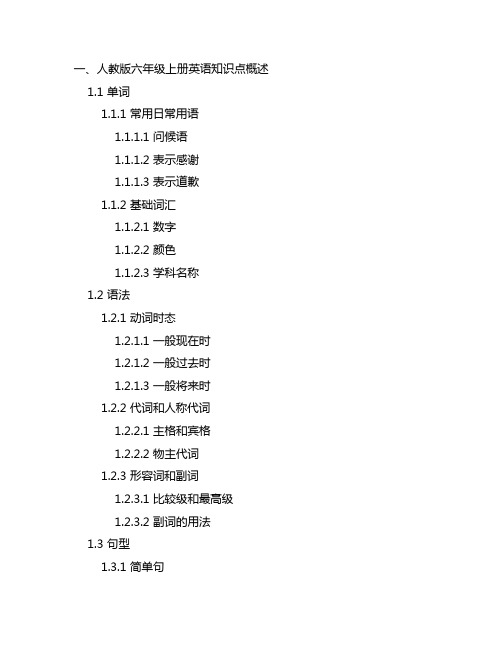
一、人教版六年级上册英语知识点概述1.1 单词1.1.1 常用日常用语1.1.1.1 问候语1.1.1.2 表示感谢1.1.1.3 表示道歉1.1.2 基础词汇1.1.2.1 数字1.1.2.2 颜色1.1.2.3 学科名称1.2 语法1.2.1 动词时态1.2.1.1 一般现在时1.2.1.2 一般过去时1.2.1.3 一般将来时1.2.2 代词和人称代词1.2.2.1 主格和宾格1.2.2.2 物主代词1.2.3 形容词和副词1.2.3.1 比较级和最高级1.2.3.2 副词的用法1.3 句型1.3.1 简单句1.3.1.1 肯定句1.3.1.2 否定句1.3.1.3 疑问句1.3.2 复合句1.3.2.1 并列句1.3.2.2 定语从句1.3.2.3 状语从句二、人教版六年级上册英语知识点详解2.1 单词2.1.1 常用日常用语2.1.1.1 问候语问候语是指在英语日常交际中用于打招呼和示好的常用词汇,包括Hello、Hi、Good morning、Good afternoon等等。
2.1.1.2 表示感谢表示感谢的常用词汇有Thank you、Thanks a lot、Thank you very much等,用于表达对别人的帮助或礼物表示感激之情。
2.1.1.3 表示道歉表示道歉的词汇包括I'm sorry、Excuse me、Pardon等,在日常生活中,用于向别人道歉或请求对方让步的场合。
2.1.2 基础词汇2.1.2.1 数字数字是英语基础词汇的重要部分,包括基本的数字表达方式和计量单位,如one、two、three等,以及hundred、thousand等。
2.1.2.2 颜色颜色是描述事物外观的重要词汇,在日常交流中也经常用到,包括red、blue、yellow等常见颜色词汇。
2.1.2.3 学科名称学科名称涉及到人们日常生活和学习工作的方方面面,包括mathematics、music、art等,是学习英语时必须掌握的词汇。
小学六年级上册英语知识点归纳总结
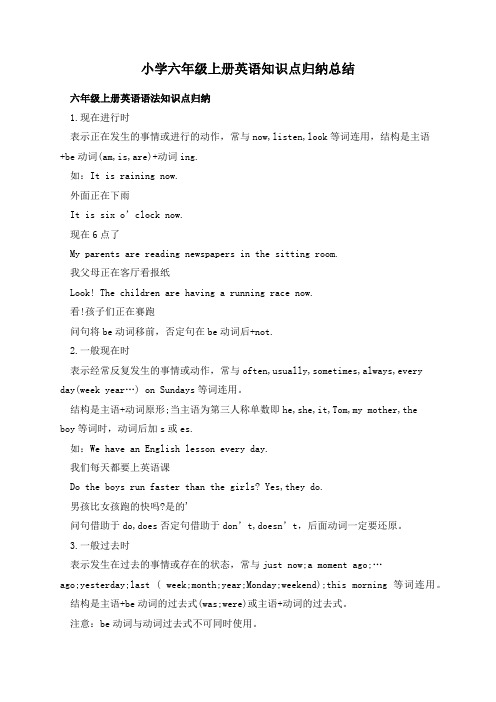
小学六年级上册英语知识点归纳总结六年级上册英语语法知识点归纳1.现在进行时表示正在发生的事情或进行的动作,常与now,listen,look等词连用,结构是主语+be动词(am,is,are)+动词ing.如:It is raining now.外面正在下雨It is six o’clock now.现在6点了My parents are reading newspapers in the sitting room.我父母正在客厅看报纸Look! The children are having a running race now.看!孩子们正在赛跑问句将be动词移前,否定句在be动词后+not.2.一般现在时表示经常反复发生的事情或动作,常与often,usually,sometimes,always,every day(week year…) on Sundays等词连用。
结构是主语+动词原形;当主语为第三人称单数即he,she,it,Tom,my mother,theboy等词时,动词后加s或es.如:We have an English lesson every day.我们每天都要上英语课Do the boys run faster than the girls? Yes,they do.男孩比女孩跑的快吗?是的'问句借助于do,does否定句借助于don’t,doesn’t,后面动词一定要还原。
3.一般过去时表示发生在过去的事情或存在的状态,常与just now;a moment ago;…ago;yesterday;last ( week;month;year;Monday;weekend);this morning等词连用。
结构是主语+be动词的过去式(was;were)或主语+动词的过去式。
注意:be动词与动词过去式不可同时使用。
如:My earphones were on the ground just now.我的耳机刚刚还在呢。
英语六上语法总结

英语六上语法总结
以下是英语六年级上的语法总结:
1. 现在进行时:表示正在进行的动作或存在的状态。
结构为“be动词+动词的现在分词”。
2. 情态动词can的用法:表示能力、请求或允许等。
结构为“can+动词原形”。
3. 特殊疑问句:用来询问某个特定的问题,结构为“疑问词+be动词/助动词/情态动词+主语+谓语”。
4. 祈使句:表示请求、命令或建议等,结构为“动词原形+宾语+其他成分”。
5. 动词的过去式和过去分词:表示过去的动作或状态,结构为“动词原形+ed”或“动词原形+d/en”。
6. 形容词的比较级和最高级:表示形容词之间的比较关系,结构为“形容词原级+than”或“形容词原级+the+最高级”。
7. 序数词:表示事物的顺序,结构为“基数词+序数词后缀”。
8. 感叹句:用来表达强烈的感情或惊讶等,结构为“what+名词”或“how+形容词/副词”。
9. 介词的用法:表示事物之间的关系或位置,常用的介词有in、on、under、next to等。
10. there be句型:表示存在关系,结构为“there be+主语+地点/时间状语”。
以上是英语六年级上的重点语法知识点,需要掌握它们的含义、用法和基本结构。
同时,还需要注意在日常交际中运用这些语法知识,提高自己的英语表达能力。
六年级上册英语一到六单元知识总结
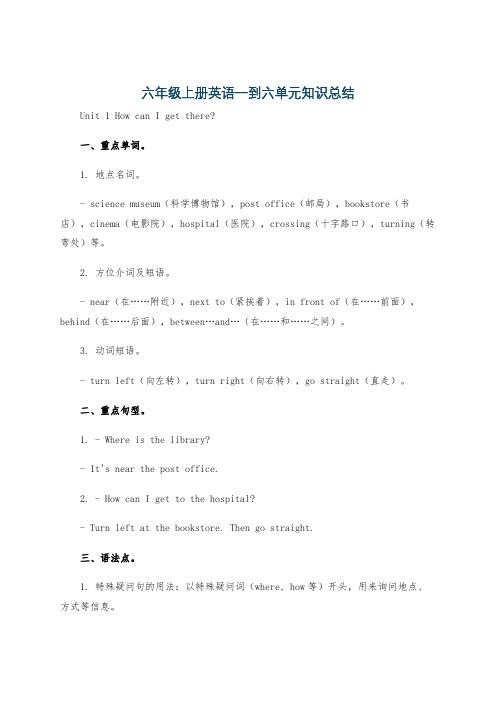
六年级上册英语一到六单元知识总结Unit 1 How can I get there?一、重点单词。
1. 地点名词。
- science museum(科学博物馆),post office(邮局),bookstore(书店),cinema(电影院),hospital(医院),crossing(十字路口),turning(转弯处)等。
2. 方位介词及短语。
- near(在……附近),next to(紧挨着),in front of(在……前面),behind(在……后面),between…and…(在……和……之间)。
3. 动词短语。
- turn left(向左转),turn right(向右转),go straight(直走)。
二、重点句型。
1. - Where is the library?- It's near the post office.2. - How can I get to the hospital?- Turn left at the bookstore. Then go straight.三、语法点。
1. 特殊疑问句的用法:以特殊疑问词(where, how等)开头,用来询问地点、方式等信息。
2. 一般现在时在问路指路中的运用。
Unit 2 Ways to go to school.一、重点单词。
1. 交通工具名词。
- by bike(骑自行车),by bus(乘公共汽车),by train(乘火车),by plane(乘飞机),on foot(步行),ship(轮船),subway(地铁)等。
2. 形容词。
- slow(慢的),fast(快的)。
3. 其他。
- traffic(交通),traffic lights(交通灯),stop(停),wait(等)。
二、重点句型。
1. - How do you come to school?- Usually, I come on foot.2. - How can I get to the Fuxing Hospital?- Take the No. 57 bus over there.三、语法点。
六年级上册语法和知识点总结

六年级上册语法和知识点总结1. How long 问,长度(meter/kilometer )How long is the Great Wall? It 'about six thousand seven hundred kilometers.2. How big 问,人口( people)How big is Beiji ng? /What is the populati on of Beiji ng?/How large is the population of Beijing ?Beijing 'got about fourteen million people .3. How many问数字+名词复数How many countries are in the UN? 191 countries are in the UN.4. Where 问,地点/方向Where'New York? It' in the east of America.5. When问,时间When is the UN building open? The UN building is open at 9:45.6. What time 问,钟点What time is it? It s ten to five.7. What •••doi ng 问,动词ing What are you doing ? I ' m sending an email.8. What(is …的hobby)问,爱好What is your hobby? Collecting stamps is my hobby./I like collecting stamps.9. What •••do问,动词(事情)What do you do on Thanksgiving Day? We always have a special meal.10. Who问,人物Who can be your pen friend? Jim can be my pen friend.11. Why 问,becauseWhy can Jim be your pen friend? Because he can speak French.12. What问,物品What is it? It's a train.What问,职业What are you?/What do you do/what does she/he do? I'm a pupil.What问,节日。
六上英语必背知识点
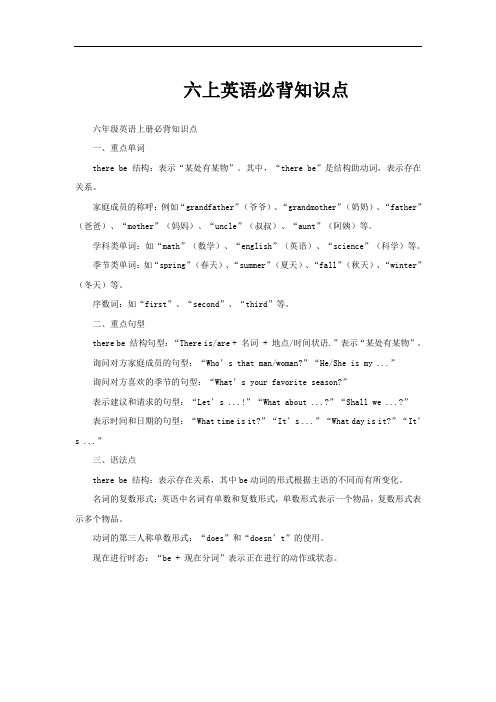
六上英语必背知识点六年级英语上册必背知识点一、重点单词there be 结构:表示“某处有某物”。
其中,“there be”是结构助动词,表示存在关系。
家庭成员的称呼:例如“grandfather”(爷爷)、“grandmother”(奶奶)、“father”(爸爸)、“mother”(妈妈)、“uncle”(叔叔)、“aunt”(阿姨)等。
学科类单词:如“math”(数学)、“english”(英语)、“science”(科学)等。
季节类单词:如“spring”(春天)、“summer”(夏天)、“fall”(秋天)、“winter”(冬天)等。
序数词:如“first”、“second”、“third”等。
二、重点句型there be 结构句型:“There is/are + 名词 + 地点/时间状语.”表示“某处有某物”。
询问对方家庭成员的句型:“Who’s that man/woman?”“He/She is my ...”询问对方喜欢的季节的句型:“What’s your favorite season?”表示建议和请求的句型:“Let’s ...!”“What about ...?”“Shall we ...?”表示时间和日期的句型:“What time is it?”“It’s ...”“What day is it?”“It’s ...”三、语法点there be 结构:表示存在关系,其中be动词的形式根据主语的不同而有所变化。
名词的复数形式:英语中名词有单数和复数形式,单数形式表示一个物品,复数形式表示多个物品。
动词的第三人称单数形式:“does”和“doesn’t”的使用。
现在进行时态:“be + 现在分词”表示正在进行的动作或状态。
六年级上册英语1-4单元必考知识点总结

Unit 3 What are you going to do?
一.词汇 'next week 下周
newsp叩er 报纸
this morning 今天上午
comic book漫画书
Time: (时间)
this afternoon 今天下午 this evening今天晚上
magazine 杂志 dictionary 字典
make kites (making kites )制作风筝 colLect stamps (collecting stamps)集邮
三单
Live (lives)居住,住 teach (teaches)教 go (goes)去 watch (watches)看 read (reads)读
其他show (展览)
(交通工具前加by,表示乘坐但步行要用on foot)
三会一
fifth第五 difference 不同 country 国家 right右边的 Australia澳大利亚 if如果
remember 记住 same相同的 mean意思是
side 边 however 但是 must必须
find找到 every每个所有的 drive驾驶
do (does) pen pal(笔友)
dear (亲爱的)
look(看上去)fun(快乐,乐趣)
with(同…)
三、重点句型:
1 .询问某人的爱好:
---------- What's your hobby?你的爱好是什么?
-----------1 Like collecting stamps.我喜欢集邮 2 .表示征求别人意见:
我坐飞机去。
■ ----------- How does your father go to work? ----------- He goes to work by subway.
六年级上英语语法知识点归纳
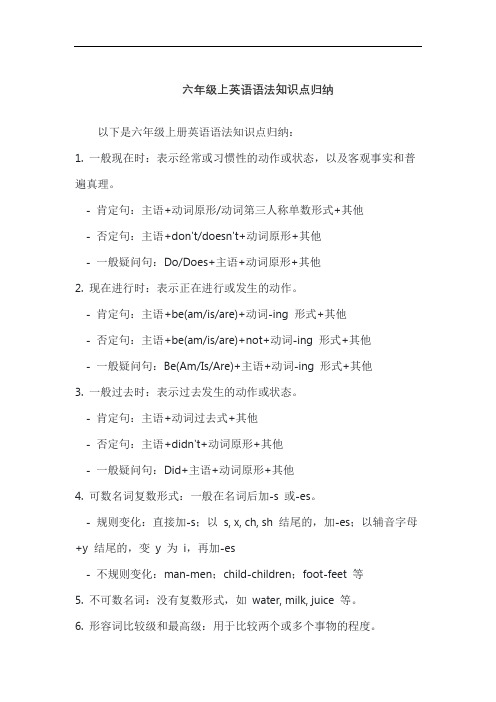
六年级上英语语法知识点归纳以下是六年级上册英语语法知识点归纳:1. 一般现在时:表示经常或习惯性的动作或状态,以及客观事实和普遍真理。
- 肯定句:主语+动词原形/动词第三人称单数形式+其他- 否定句:主语+don't/doesn't+动词原形+其他- 一般疑问句:Do/Does+主语+动词原形+其他2. 现在进行时:表示正在进行或发生的动作。
- 肯定句:主语+be(am/is/are)+动词-ing 形式+其他- 否定句:主语+be(am/is/are)+not+动词-ing 形式+其他- 一般疑问句:Be(Am/Is/Are)+主语+动词-ing 形式+其他3. 一般过去时:表示过去发生的动作或状态。
- 肯定句:主语+动词过去式+其他- 否定句:主语+didn't+动词原形+其他- 一般疑问句:Did+主语+动词原形+其他4. 可数名词复数形式:一般在名词后加-s 或-es。
- 规则变化:直接加-s;以s, x, ch, sh 结尾的,加-es;以辅音字母+y 结尾的,变y 为i,再加-es- 不规则变化:man-men;child-children;foot-feet 等5. 不可数名词:没有复数形式,如water, milk, juice 等。
6. 形容词比较级和最高级:用于比较两个或多个事物的程度。
- 比较级:在形容词后加-er;部分双音节和多音节形容词,在词前加more- 最高级:在形容词后加-est;部分双音节和多音节形容词,在词前加most7. 介词:表示时间、地点、方位等的词语,如in, on, at, under, behind 等。
8. 冠词:a/an(不定冠词),the(定冠词)。
9. 代词:包括人称代词、物主代词、反身代词等。
10. 疑问词:用于构成疑问句,如what, who, where, when, why 等。
英语六年级上册必考知识点
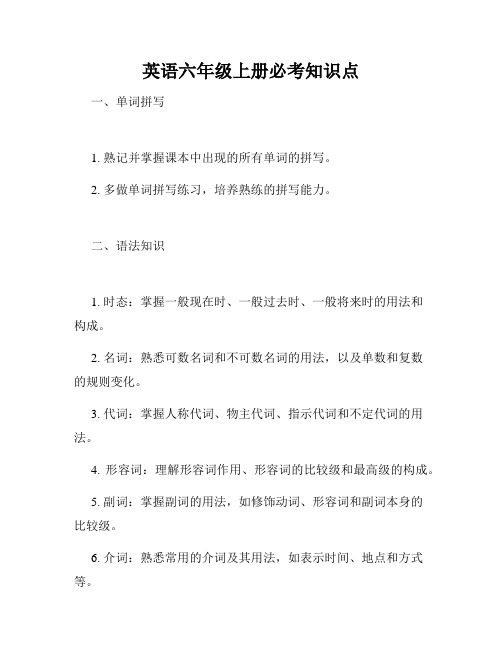
英语六年级上册必考知识点一、单词拼写1. 熟记并掌握课本中出现的所有单词的拼写。
2. 多做单词拼写练习,培养熟练的拼写能力。
二、语法知识1. 时态:掌握一般现在时、一般过去时、一般将来时的用法和构成。
2. 名词:熟悉可数名词和不可数名词的用法,以及单数和复数的规则变化。
3. 代词:掌握人称代词、物主代词、指示代词和不定代词的用法。
4. 形容词:理解形容词作用、形容词的比较级和最高级的构成。
5. 副词:掌握副词的用法,如修饰动词、形容词和副词本身的比较级。
6. 介词:熟悉常用的介词及其用法,如表示时间、地点和方式等。
7. 动词:了解动词的原形、过去式和过去分词的构成规则。
8. 人称代词和动词的一致性:掌握人称代词与动词之间的一致关系。
三、句型转换1. 肯定句转变为否定句和疑问句:掌握否定句和一般疑问句的构成规则。
2. 一般疑问句转变为肯定句和否定句:掌握回答一般疑问句的肯定和否定形式。
四、阅读理解1. 熟练阅读课本中的短文,并理解主旨内容。
2. 掌握从短文中获取关键信息的技巧,如寻找细节和推理等。
3. 培养阅读理解的速度和准确性,多做阅读练习。
五、写作能力1. 能够运用学到的基础词汇和语法知识,写出简单的句子和段落。
2. 培养表达思想的能力,逐渐提高写作的准确性和流畅性。
六、听力技巧1. 听力理解:提高听力的准确性和处理信息的能力。
2. 听写能力:提高听写的准确性和速度,注意拼写正确。
以上就是英语六年级上册必考的知识点汇总,希望同学们在备考过程中能够重点关注这些内容,加强基础,提高自身的英语水平。
祝大家取得好成绩!。
六年级英语上册知识点归纳

六年级英语上册知识点归纳一、单词与词组1. 数字:zero, one, two, three, four, five, six, seven, eight, nine, ten, eleven, twelve, thirteen, fourteen, fifteen, sixteen, seventeen, eighteen, nineteen, twenty, thirty, forty, fifty, sixty, seventy, eighty, ninety, hundred.2. 问候与礼貌用语:hello, hi, good morning/afternoon/evening, goodbye, please, thank you, sorry, excuse me.3. 人称代词:I, you, he, she, it, we, they.4. 冠词:a, an, the.5. 介词:in, on, at, under, over, beside, between, behind, in front of.6. 家庭成员与亲属关系:father, mother, sister, brother, grandma, grandpa, aunt, uncle, cousin.7. 学科与课程:Chinese, English, math, science, music, art, P.E., history, geography.8. 学校设施:classroom, playground, library, canteen, computer room, gym, art room.9. 食物与饮料:apple, banana, orange, watermelon, sandwich, cake, ice cream, juice, milk, tea.10. 动物:cat, dog, rabbit, bird, fish, turtle, panda, tiger, lion, monkey, elephant.11. 颜色:red, yellow, blue, green, orange, purple, white, black, brown.12. 季节与天气:spring, summer, autumn, winter, sunny, rainy, cloudy, snowy, windy.13. 国家与国旗:China, America, Canada, England, Japan, Australia, France, Germany.14. 时间:morning, afternoon, evening, night.15. 体育项目:running, swimming, jumping, dancing, basketball, football, volleyball.二、句型与语法1. 陈述句:主语+谓语+宾语。
小学六年级英语(上册)知识归纳|人教版 笔记 重点
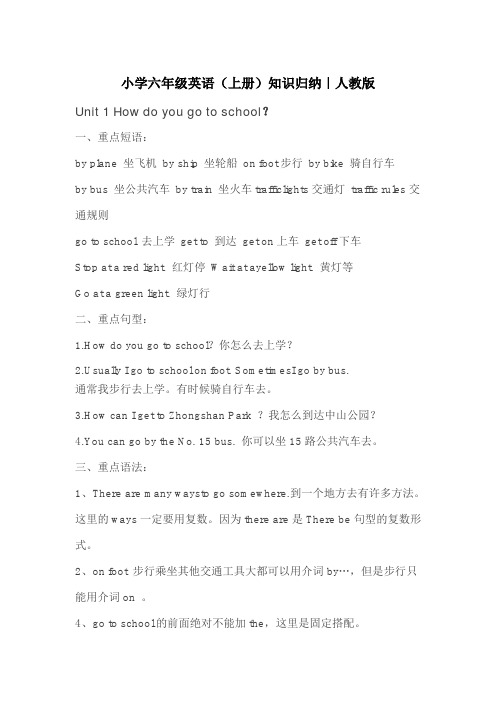
小学六年级英语(上册)知识归纳|人教版Unit 1 How do you go to school?一、重点短语:by plane 坐飞机by ship 坐轮船on foot步行by bike 骑自行车by bus 坐公共汽车by train 坐火车trafficlights交通灯traffic rules交通规则go to school 去上学get to 到达get on上车get off下车Stop at a red light. 红灯停Wait at ayellow light. 黄灯等Go at a green light. 绿灯行二、重点句型:1.How do you go to school?你怎么去上学?ually I go to school on foot. SometimesI go by bus.通常我步行去上学。
有时候骑自行车去。
3.How can I get to Zhongshan Park ?我怎么到达中山公园?4.You can go by the No. 15 bus. 你可以坐15路公共汽车去。
三、重点语法:1、There are many waysto go somewhere.到一个地方去有许多方法。
这里的ways一定要用复数。
因为there are是There be句型的复数形式。
2、on foot 步行乘坐其他交通工具大都可以用介词by…,但是步行只能用介词on 。
4、go to school的前面绝对不能加the,这里是固定搭配。
5、USA 和US 都是美国的意思。
另外America也是美国的意思。
6、go to the park 前面一定要加the. 如果要去的地方有具体的名字,就不能再加the ,如果要去的地方没有具体名字,都要在前面加the. (go to school除外。
)7、How do you go to …?你怎样到达某个地方?如果要问的是第三人称单数,则要用:How does he/she…go to …?8、反义词:get on(上车)---get off(下车)near(近的)—far(远的)fast(快的)—slow(慢的)because(因为)—why(为什么)same(相同的)—different(不同的)9、近义词:see you---goodbye sure---certainly---ofcourse10、频度副词:always 总是,一直usually 通常often经常sometimes 有时候never 从来不Unit 2 Where is the science museum?一、重点短语:library 图书馆post office 邮局hospital医院cinema 电影院bookstore书店science museum科学博物馆turnleft向左转turn right 向右转go straight 直行north北south南east东west西next to靠近、与……。
pep六年级上册英语所有重点语法知识点

pep六年级上册英语所有重点语法知识点摘要:1.名词2.冠词3.代词4.介词5.动词6.形容词7.副词8.句子结构9.疑问句和否定句10.宾语从句11.状语从句12.同位语从句13.感叹句14.条件句15.祈使句16.动词时态17.被动语态18.情态动词19.非谓语动词20.复合句正文:在PEP 六年级上册英语中,有很多重要的语法知识点需要我们掌握。
下面我将详细列出这些知识点,并简要介绍它们。
1.名词:名词是表示人、物、地方或抽象概念的词。
它们可分为可数名词和不可数名词。
可数名词可以分为单数和复数形式。
2.冠词:冠词分为定冠词(the)和不定冠词(a/an)。
定冠词表示特指,不定冠词表示泛指。
3.代词:代词是代替名词的词。
主要有人称代词、物主代词和指示代词等。
4.介词:介词表示名词、代词或其他词类之间的关系。
常见的介词有in、on、at、to 等。
5.动词:动词表示动作或状态。
动词可分为及物动词和不及物动词。
及物动词需要宾语,不及物动词不需要宾语。
6.形容词:形容词修饰名词,表示人或物的性质、特征或状态。
形容词可分为原级、比较级和最高级。
7.副词:副词修饰动词、形容词、其他副词或整个句子,表示程度、方式、地点、时间等。
8.句子结构:句子结构包括主语、谓语、宾语、定语、状语和补语。
9.疑问句和否定句:疑问句用于提问,否定句用于表示否定意义。
10.宾语从句:宾语从句是作为宾语的句子,通常由连词(如that、whether 等)引导。
11.状语从句:状语从句是修饰主句的句子,通常由连词(如because、since 等)或副词(如how、where 等)引导。
12.同位语从句:同位语从句是解释或说明名词的句子,通常由连词(如that、whether 等)引导。
13.感叹句:感叹句表示强烈的感情或情绪,通常由感叹词(如oh、ah 等)引导。
14.条件句:条件句表示条件与结果之间的关系,通常由连词(如if、unless 等)引导。
英语六年级上学期知识点
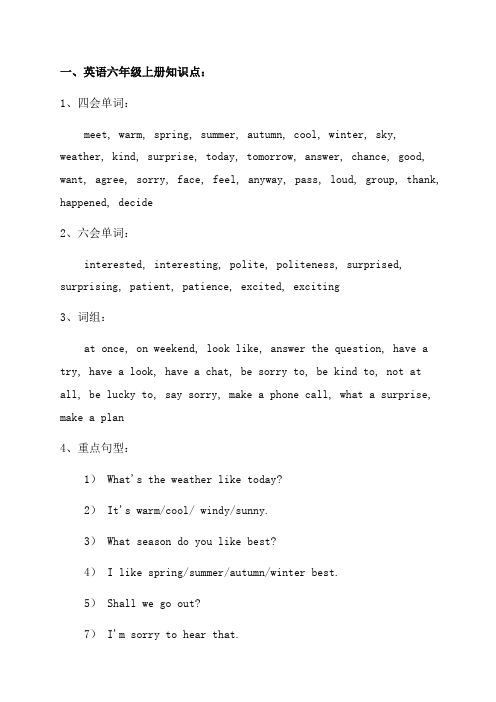
一、英语六年级上册知识点:1、四会单词:meet, warm, spring, summer, autumn, cool, winter, sky, weather, kind, surprise, today, tomorrow, answer, chance, good, want, agree, sorry, face, feel, anyway, pass, loud, group, thank, happened, decide2、六会单词:interested, interesting, polite, politeness, surprised, surprising, patient, patience, excited, exciting3、词组:at once, on weekend, look like, answer the question, have a try, have a look, have a chat, be sorry to, be kind to, not at all, be lucky to, say sorry, make a phone call, what a surprise, make a plan4、重点句型:1) What's the weather like today?2) It's warm/cool/ windy/sunny.3) What season do you like best?4) I like spring/summer/autumn/winter best.5) Shall we go out?7) I'm sorry to hear that.9) I'd love to.10) I agree with you.11) I disagree with you.12) What happened?13) Would you like to join us?14) I'm sorry, I can't.15) I'd like to have a try.16) It sounds exciting.17) What a surprise!18) Let's decide together.19) Let's make a plan.20) Shall we have a chat?二、六年级上册语法知识:1、紧缩形式:I'm = I amShe's = She isHe's = He isYou're = You are2、疑问句:Shall we go? 咱们去吗?Would you like to join us? 你想加入我们吗?What's the weather like today? 今天天气怎么样?What season do you like best? 你最喜欢哪个季节?3、情态动词:Can 能;可以Must 必须Mustn't 不可以Should 应该Shouldn't 不该4、动词的时态:一般现在时:表示动作发生的经常性或习惯一般过去时:表示动作已经发生以及有的结果5、There be 句型:There is a lake in the park. 公园里有一个湖There are many flowers in the garden. 花园里有许多花6、代词:I我You 你,你们He他She 她It它We我们They 他们7、祈使句:Let's go! 咱们走吧!Let's make a plan. 咱们来制定一个计划吧。
(完整版)六年级英语上册重点知识点及语法
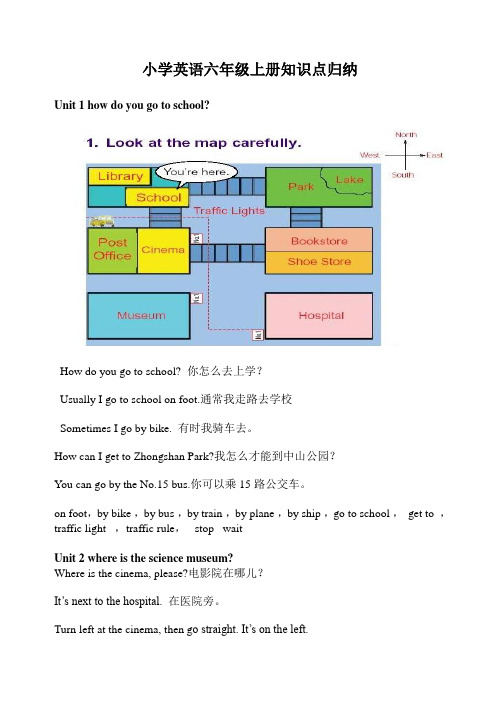
在电影院左转,然后直走,它就在左边
library post,office hospital ,cinema , bookstore , next to , turn right , turn left , go straight , then ,
Unit 3 what are you going to do? What are you going to do on the weekend?周末你准备去哪儿?
(一)名词单复数
1.一般情况,直接加-s,如:book-books, bag-bags, cat-cats, bed-beds 2 . 以 s. x. sh. ch 结 尾 , 加 -es , 如 : bus-buses, box-boxes, brush-brushes,
watch-watches 3 . 以 “ 辅 音 字 母 +y” 结 尾 , 变 y 为 i, 再 加 -es , 如 : family-families,
Betty: Which bus can you take ? Tom: I can take the No.18 bus. Betty:How do you go to my home,Mary? Mary: Oh, My home is quite far from yours. I go there by car. My father is free today. He can
九、阅读理解。(10%)
Today is Betty’s birthday. Some friends will go to Betty’s home. They are Lucy,Tom,Mary and Jack. Betty: Hello,Lucy! How do you go to my home? Lucy: I go to your home by bike because it’s near. Betty: How about you ,Tom? Tom: I go there by bus .
人教版小学六年级英语上册知识点总结和复习要点
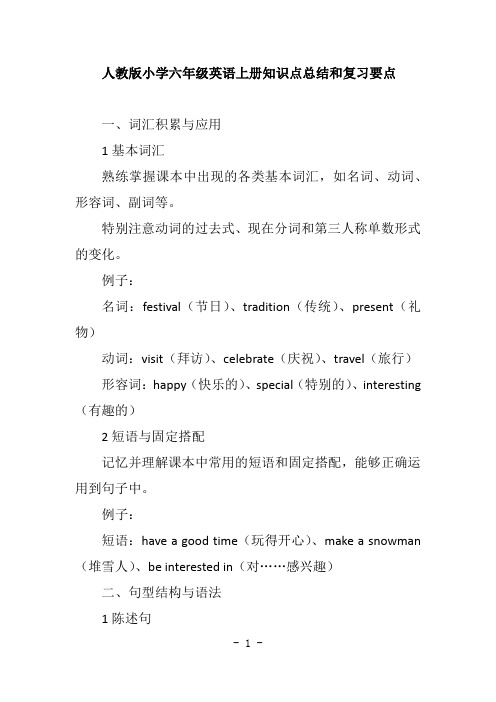
人教版小学六年级英语上册知识点总结和复习要点一、词汇积累与应用1基本词汇熟练掌握课本中出现的各类基本词汇,如名词、动词、形容词、副词等。
特别注意动词的过去式、现在分词和第三人称单数形式的变化。
例子:名词:festival(节日)、tradition(传统)、present(礼物)动词:visit(拜访)、celebrate(庆祝)、travel(旅行)形容词:happy(快乐的)、special(特别的)、interesting (有趣的)2短语与固定搭配记忆并理解课本中常用的短语和固定搭配,能够正确运用到句子中。
例子:短语:have a good time(玩得开心)、make a snowman (堆雪人)、be interested in(对……感兴趣)二、句型结构与语法1陈述句复习并巩固陈述句的基本结构,能够正确构建和表达完整的句子。
例子:陈述句:I like playing football in the afternoon.(我喜欢下午踢足球。
)2疑问句学习和掌握特殊疑问句、一般疑问句及其回答方式,能够准确理解并回答问题。
例子:特殊疑问句:What do you usually do on your birthday?(你生日通常做什么?)回答:I usually have a birthday party with my friends.(我通常和朋友们一起举办生日派对。
)3祈使句巩固祈使句的基本用法,能够正确使用祈使句表达请求、命令或建议。
例子:祈使句:Please don’t forget to bring your homework tomorrow.(请别忘了明天带作业来。
)4时态复习并巩固一般现在时、一般过去时、一般将来时和现在进行时等时态的基本用法和形式。
例子:一般现在时:She often reads books after dinner.(她晚饭后经常看书。
)一般过去时:We went to the zoo last weekend and saw many animals.(我们上周末去了动物园,看到了很多动物。
六年级上册英语人教版语法知识点

六年级上册英语人教版语法知识点以下是六年级上册英语人教版的一些语法知识点:1. 动词be(is,am,are)的用法当主语为第一人称(I)、第二人称(you)以及第三人称单数(he,she,it)时,使用am;当主语为第二人称(you)和第三人称复数(they,we)时,使用are;当主语为第三人称单数(he,she,it)时,使用is。
肯定句:主语 + be动词 + 其他成分。
例如:I am a student.否定句:在be动词后面加not。
例如:He is not a teacher.2. 情态动词can的用法表示能力或可能性,后面跟动词原形。
例如:I can swim.否定句形式为cannot,缩写为can't。
例如:I can't run fast.3. 特殊疑问句以what,who,which,where,how等疑问词开头的句子。
例如:What time is it?回答特殊疑问句时,一般使用“疑问词 + 动词be/助动词do + 主语 +其他成分”的句型。
例如:It's 8:00 o'clock.4. 一般现在时表示经常性或习惯性的动作或状态。
例如:I usually get up at 7:00 in the morning.表示客观事实或普遍真理。
例如:The sun rises in the east.5. 现在进行时表示正在进行的动作或状态。
结构为“主语 + be动词 + -ing形式”。
例如:They are playing basketball now.6. 现在完成时表示过去的某个动作对现在造成的影响或结果。
结构为“主语 +have/has + 过去分词”。
例如:I have finished my homework.7. 序数词和基数词表示顺序的数字叫序数词,如first、second、third等。
表示数量的数字叫基数词,如one、two、three等。
六年级上英语知识点归纳总结
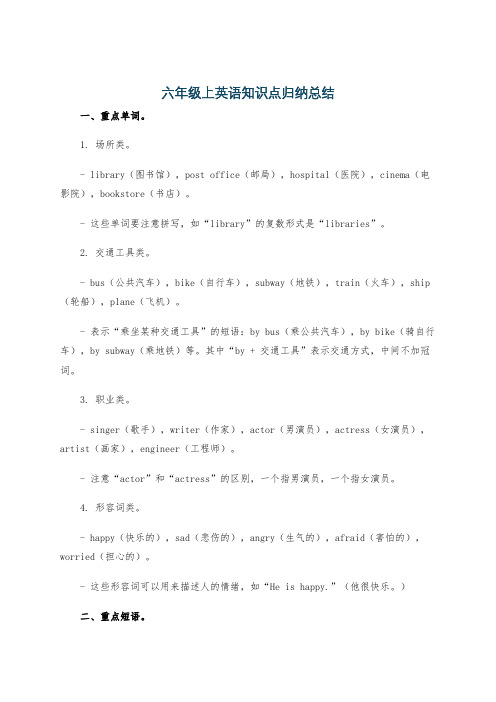
六年级上英语知识点归纳总结一、重点单词。
1. 场所类。
- library(图书馆),post office(邮局),hospital(医院),cinema(电影院),bookstore(书店)。
- 这些单词要注意拼写,如“library”的复数形式是“libraries”。
2. 交通工具类。
- bus(公共汽车),bike(自行车),subway(地铁),train(火车),ship (轮船),plane(飞机)。
- 表示“乘坐某种交通工具”的短语:by bus(乘公共汽车),by bike(骑自行车),by subway(乘地铁)等。
其中“by + 交通工具”表示交通方式,中间不加冠词。
3. 职业类。
- singer(歌手),writer(作家),actor(男演员),actress(女演员),artist(画家),engineer(工程师)。
- 注意“actor”和“actress”的区别,一个指男演员,一个指女演员。
4. 形容词类。
- happy(快乐的),sad(悲伤的),angry(生气的),afraid(害怕的),worried(担心的)。
- 这些形容词可以用来描述人的情绪,如“He is happy.”(他很快乐。
)二、重点短语。
1. 问路相关。
- turn left(向左转),turn right(向右转),go straight(直走)。
- 例如:“Go straight and then turn left at the second crossing.”(直走然后在第二个十字路口左转。
)2. 兴趣爱好相关。
- read books(读书),see a film(看电影),take a trip(去旅行),go hiking(去远足)。
- 例如:“I like to read books on weekends.”(我喜欢在周末读书。
)三、重点句型。
1. 询问地点。
- Where is the + 地点?例如:“Where is the post office?”(邮局在哪里?)- 回答:It's + 方位介词短语。
六年级上册英语常用知识点
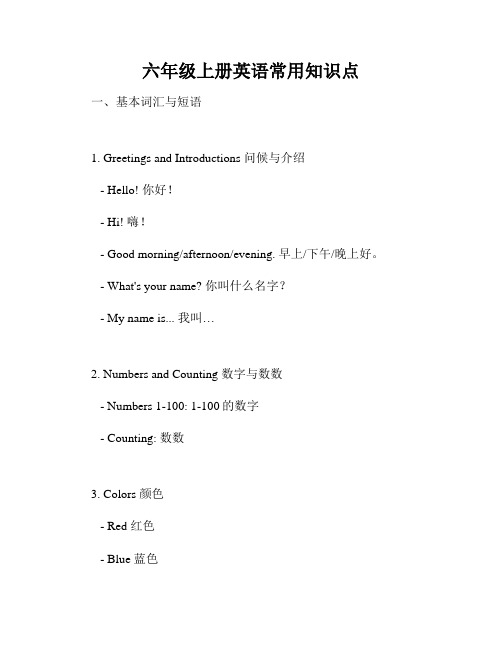
六年级上册英语常用知识点一、基本词汇与短语1. Greetings and Introductions 问候与介绍- Hello! 你好!- Hi! 嗨!- Good morning/afternoon/evening. 早上/下午/晚上好。
- What's your name? 你叫什么名字?- My name is... 我叫…2. Numbers and Counting 数字与数数- Numbers 1-100: 1-100的数字- Counting: 数数3. Colors 颜色- Red 红色- Blue 蓝色- Green 绿色- Yellow 黄色- Orange 橙色- Purple 紫色4. Days of the Week and Months of the Year 星期与月份 - Days of the Week: 星期- Months of the Year: 月份5. Family 家庭- Mother 母亲- Father 父亲- Sister 姐妹- Brother 兄弟二、基本语法1. Simple Present Tense 现在简单时- Affirmative, Negative, and Interrogative sentences: 肯定句、否定句、疑问句- Third person singular: 第三人称单数2. Present Continuous Tense 现在进行时- Affirmative, Negative, and Interrogative sentences: 肯定句、否定句、疑问句3. Question Words 疑问词- Who? 谁?- What? 什么?- When? 什么时候?- Where? 在哪里?- Why? 为什么?- How? 如何?4. Prepositions 介词- In, On, Under, Next to, Between: 在…里,在…上,在…下,在…旁边,在…之间三、日常用语与交际技巧1. Asking for Help 请求帮助- Could you please help me? 你能帮个忙吗?- Can you show me...? 你能给我看看…吗?- I need your assistance. 我需要你的帮助。
人教版六年级上册英语知识点

人教版六年级上册英语知识点人教版六年级上册英语知识点概述一、词汇与短语1. 学校相关词汇- 教室(classroom)- 图书馆(library)- 操场(playground)- 办公室(office)- 食堂(canteen)2. 日常活动- 做作业(do homework)- 看书(read books)- 玩游戏(play games)- 听音乐(listen to music)- 做家务(do chores)3. 常见动物- 狗(dog)- 猫(cat)- 鸟(bird)- 鱼(fish)- 兔子(rabbit)4. 食物与饮料- 水果(fruit)- 蔬菜(vegetables)- 米饭(rice)- 面条(noodles)- 牛奶(milk)5. 家庭成员- 父亲(father)- 母亲(mother)- 兄弟(brother)- 姐妹(sister)- 祖父(grandfather)- 祖母(grandmother)二、语法要点1. 一般现在时- 描述经常发生的动作或状态。
- 使用动词原形,第三人称单数时动词加-s。
2. 一般过去时- 描述过去发生的动作或状态。
- 规则动词加-ed,不规则动词需记忆其过去式形式。
3. 现在进行时- 描述正在进行的动作。
- 结构为be动词(am/is/are)+ 动词-ing形式。
4. 可数名词与不可数名词- 可数名词有单数和复数形式,不可数名词通常没有复数形式。
5. 代词- 主格代词(I, you, he, she, it, we, they)- 宾格代词(me, you, him, her, it, us, them)- 形容词性物主代词(my, your, his, her, its, our, their)- 名词性物主代词(mine, yours, his, hers, its, ours,theirs)三、句型结构1. 简单句- 陈述句:表达事实或状态。
- 1、下载文档前请自行甄别文档内容的完整性,平台不提供额外的编辑、内容补充、找答案等附加服务。
- 2、"仅部分预览"的文档,不可在线预览部分如存在完整性等问题,可反馈申请退款(可完整预览的文档不适用该条件!)。
- 3、如文档侵犯您的权益,请联系客服反馈,我们会尽快为您处理(人工客服工作时间:9:00-18:30)。
小学英语六年级上册知识点归纳Unit 1 how do you go to school?How do you go to school? 你怎么去上学?Usually I go to school on foot.通常我走路去学校Sometimes I go by bike. 有时我骑车去。
How can I get to Zhongshan Park?我怎么才能到中山公园?You can go by the No.15 bus.你可以乘15路公交车。
on foot,by bike ,by bus ,by train ,by plane ,by ship ,go to school ,get to ,traffic light ,traffic rule,stop waitUnit 2 where is the science museum?Where is the cinema, please?电影院在哪儿?It’s next to the hospital. 在医院旁。
Turn left at the cinema, then g o straight. It’s on the left.在电影院左转,然后直走,它就在左边library post,office hospital ,cinema ,bookstore ,next to , turn right ,turn left ,go straight ,then ,Unit 3 what are you going to do?What are you going to do on the weekend?周末你准备去哪儿?I’m going to visit my grandparents this weekend. 这个周末我要去看望我祖父母。
Where are you going this afternoon?今天下午你去哪儿?I’m going to the bookstore. 我要去书店。
What are you going to buy? 你要去买什么?I am going to buy a comic book..我要去买一本漫画书。
next week ,this morning ,this afternoon ,this evening ,comic book ,newspaper,buy post card第二部分:语法知识一.名词:名词单复数,名词的格(一)名词单复数1.一般情况,直接加-s,如:book-books, bag-bags, cat-cats, bed-beds2.以s. x. sh. ch结尾,加-es,如:bus-buses, box-boxes, brush-brushes, watch-watches 3.以“辅音字母+y”结尾,变y为i, 再加-es,如:family-families, strawberry-strawberries4.以“f或fe”结尾,变f或fe为v, 再加-es,如:knife-knives5.不规则名词复数:man-men, woman-women, policeman-policemen, policewoman-policewomen, mouse-micechild-children, foot-feet, tooth-teeth, fish-fish, people-people, Chinese-Chinese, Japanese-Japanese不可数名词的复数就是原型:paper, juice, water, milk, rice, tea (二)名词的格(1) 有生命的东西的名词所有格:a)单数后加’s 如: Lucy’s ruler my father’s shirtb)以s 结尾的复数名词后加’如: his friends’ bagsc)不以s 结尾的复数后加’s children’s shoes●并列名词中,如果把’s加在最后一个名词后,表示共有, 如:Tom and Mike’s car 汤姆和迈克共有的小汽车●要表示所有物不是共有的,应分别在并列名词后加’sTom’s and Mike’s cars 汤姆和麦克各自的小汽车(2)表示无生命东西的名词通常用“ of +名词”来表示所有关系:如:a picture of the classroom a map of China二.冠词:不定冠词,定冠词种类:(1)不定冠词:a / an a unit / an uncle元音开头的可数名词前用an :an egg / an apple / an orange / an eraser / an answer / an ID card / an alarm clock / an actor / an actress / an e-mail / an address / an event / an example / an opera / an houran old man / an interesting book / an exciting sport / an action movie / an art lesson /(2)定冠词:the the egg the plane2. 用法:定冠词的用法:(1)特指某(些)人或某(些)物:The ruler is on the desk.(2)复述上文提到的人或物:He has a sweater. The sweater is new.(3)谈话双方都知道的人或物:The boys aren’t at school.(4)在序数词前:John’s birthday is February the second.(5)用于固定词组中:in the morning / afternoon / evening不用冠词的情况:(1)专有名词前:China is a big country.(2)名词前有定语:this , that , my , your , some, any , no 等:This is my baseball.(3)复数名词表示一类人和事:Monkeys can’t swim. They are teachers.(4)在节日,日期,月份,季节前:Today is Chr istmas Day. It’s Sunday.(5)一日三餐前:We have breakfast at 6:30.(6)球类棋类运动前:They often play football after class. He plays chess at home.* 但乐器前要用定冠词:I play the guitar very well.(7)学科名称前:My favorite subject is music.(8)在称呼或头衔的名词前:This is Mr Li.(9)固定词组中:at noon at night by bus三、代词:人称代词,物主代词四、形容词,副词:比较级,最高级(一)、形容词的比较级1、形容词比较级在句子中的运用:两个事物或人的比较用比较级,比较级后面一般带有单词than。
比较级前面可以用more, a little来修饰表示程度。
than后的人称代词用主格(口语中可用宾格)。
2.形容词加er的规则:⑴ 一般在词尾加er ;⑵ 以字母e 结尾,加r ;⑶ 以一个元音字母和一个辅音字母结尾,应双写末尾的辅音字母,再加er ;⑷ 以“辅音字母+y”结尾,先把y变i,再加er 。
3.不规则形容词比较级:good-better, beautiful-more beautiful(二)副词的比较级1.形容词与副词的区别(有be用形,有形用be;有动用副,有副用动)⑴在句子中形容词一般处于名词之前或be动词之后⑵副词在句子中最常见的是处于实义动词之后2.副词比较级的变化规则基本与形容词比较级相同(不规则变化:well-better, far-farther)六年级英语上册第一单元测试题二、排列句子,注意标点符号。
(15%)1.you to how do school go2. 3. 4. 5.九、阅读理解。
(10%)Today is Betty ’s birthday. Some friends will go to Betty ’s home. They are Lucy,Tom,Mary and Jack.Betty: Hello,Lucy! How do you go to my home? Lucy: I go to your home by bike because it ’s near. Betty: How about you ,Tom? Tom: I go there by bus .Betty: Which bus can you take ? Tom: I can take the No.18 bus.Betty:How do you go to my home,Mary?Mary: Oh, My home is quite far from yours. I go there by car. My father is free today. He can takeme there.Betty: Do you come to my home by bike or on foot, Jack? Jack:Oh, I go there on foot.( )1. Whose birthday is it?Hangzhou to I by go busby go No.5 bus canyou theget canBinjiang park tohow I traffic the remember rulesA. It’s Betty’s.B. It’s Mary’s.C. It’s Lucy’s.( )2.How does Tom go to Betty’s home?A.By car.B. By bus.C. By bike.( )3.Is Mary’s home far from Betty’s ?A. Yes, it is.B. Yes, it isn’t.C.No, it isn’t..( )4.How does Jack go to Betty’s home?A. On foot.B.By bike.C.by car .( )5.How many friends go to Betty’s home on foot ?A. Two.B. One.C.Three.八、1.How do you go to school ?2.I go to Hangzhou by bus .3.You can go by the No.5 bus .4.How can I get to Binjiang Park ?5.Remember the traffic rules.九、1.A 2.B 3.A 4.A 5.B单词:Unit 1☆by(经……;乘……) ☆foot(脚)☆bike(自行车)☆bus(公共汽车)☆train(火车)☆plane(飞机) ship(船)subway(地铁)☆how(怎样)☆go to school(上学)△then(然后)fifth(第五)☆traffic(交通)traffic light(交通灯)☆traffic rule(交通规则)☆stop(停)☆wait(等)remember(记住)☆get to(到达)find(寻找;找到)difference(不同;区别)same(相同的)every(每个;所有的)country(国家)△always(总是;一直)mean(意思是)drive(驾驶)right(右边)side(边)England(英国)Australia(澳大利亚)however(但是)left(左边的) if(如果)must(必须) khow(知道)Unit2☆library(图书馆) ☆post office(邮局) ☆hospital(医院) ☆cinema(电影院)☆bookstore(书店) science museum(科学博物馆) △excuse me(对不起)☆where(在哪里;到哪里) ☆please(请) ☆next to (与……相邻) far(远) supermarket(超市) bank(银行) after school(放学以后) △want (想要)buy(购买)△a pair of (一双)get off(下车) △minute(分钟) north(北)south(南) east(东) west(西)☆turn(转弯)☆right(右边)☆left(左边)☆straight(成直线地)☆than(然后)twelfth(第十二) party(聚会;派对)△ tell(告诉)start(开始)△take(乘坐)look for(寻找)unit3☆next week (下周) ☆this morning (今天上午) ☆this afternoon(今天下午)☆this evening(今天晚上)tonight(今晚)tomorrow(明天)take a trip(去旅行)read a magazine(阅读杂志)go to the cinema(去看电影)theme park(主题公园)the Great Wall(长城)busy(忙碌的)together(一起地)☆comic b ook(漫画书)☆post card(明信片)☆newspaper(报纸)magazine(杂志)dictionary(词典;字典)△shoe store (鞋店) ☆buy(购买)fruit stand(水果摊)pet shop(宠物商店) need(需要) plant(植物) else(其他;另外)shop(商店)。
